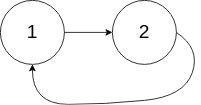public class Solution
extends Object
142 - Linked List Cycle II\.
Medium
Given the `head` of a linked list, return _the node where the cycle begins. If there is no cycle, return_ `null`.
There is a cycle in a linked list if there is some node in the list that can be reached again by continuously following the `next` pointer. Internally, `pos` is used to denote the index of the node that tail's `next` pointer is connected to ( **0-indexed** ). It is `-1` if there is no cycle. **Note that** `pos` **is not passed as a parameter**.
**Do not modify** the linked list.
**Example 1:**

**Input:** head = [3,2,0,-4], pos = 1
**Output:** tail connects to node index 1
**Explanation:** There is a cycle in the linked list, where tail connects to the second node.
**Example 2:**

**Input:** head = [1,2], pos = 0
**Output:** tail connects to node index 0
**Explanation:** There is a cycle in the linked list, where tail connects to the first node.
**Example 3:**

**Input:** head = [1], pos = -1
**Output:** no cycle
**Explanation:** There is no cycle in the linked list.
**Constraints:**
* The number of the nodes in the list is in the range [0, 104].
* -105 <= Node.val <= 105
* `pos` is `-1` or a **valid index** in the linked-list.
**Follow up:** Can you solve it using `O(1)` (i.e. constant) memory?